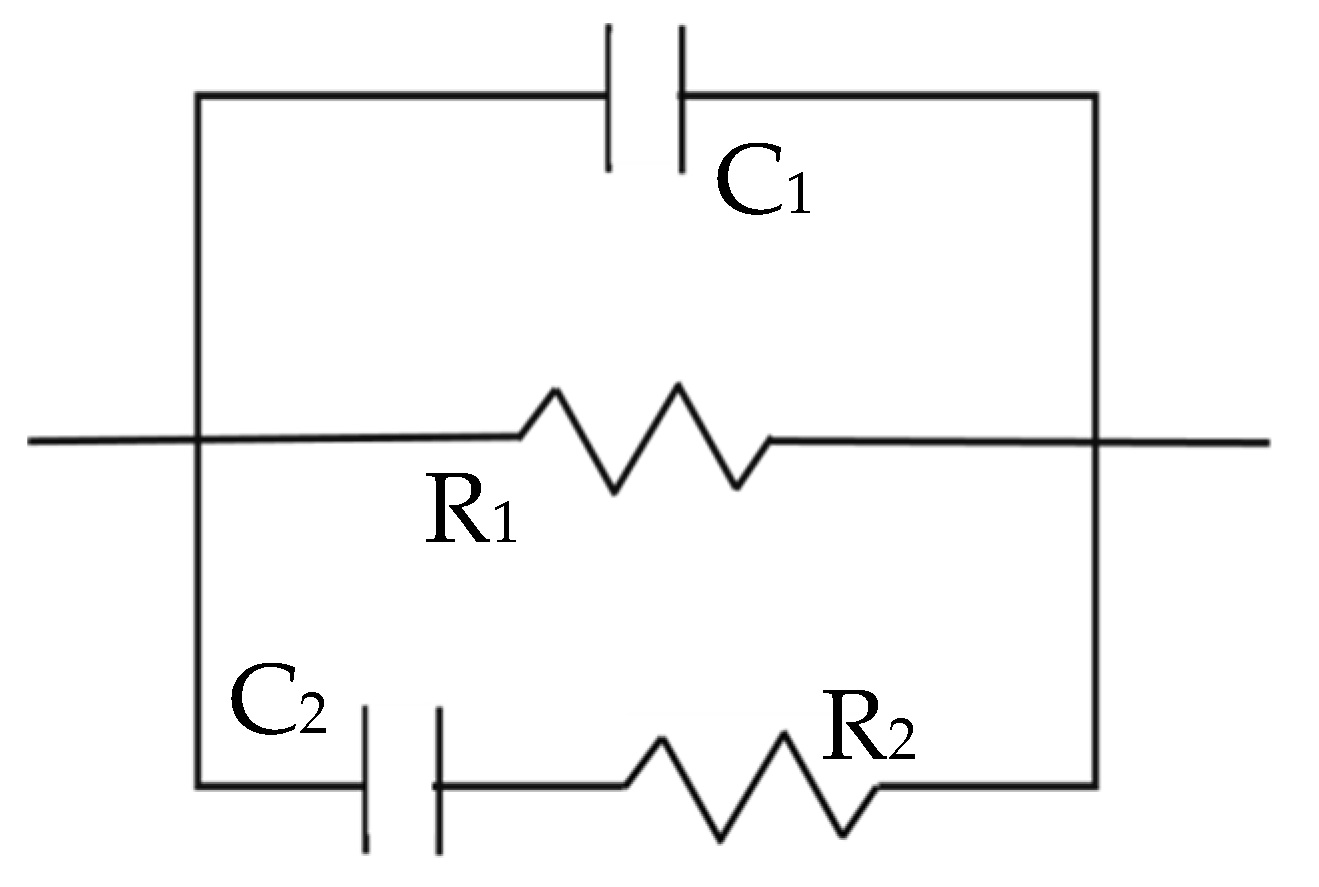The Effect of Loading on the Diffusivity of Chlorides in Mortar
Abstract
1. Introduction
2. Materials and Methods
3. Results and Discussion
3.1. Effect of an Isolated Force
3.2. Load Sustained for a Longer Period
3.3. Chloride Diffusion Coefficients Assessment
4. Conclusions
- The ionic resistance of the studied specimen is influenced by an external compressive load. Since that parameter has been numerically correlated to the chloride diffusivity, an assessment of the diffusion coefficient was provided under the influence of a load.
- In terms of the microstructural modifications, the formation of microcracks was firstly identified followed by a partial matrix reparation. The combined results of the two effects show that a load in the range of 60% of the ultimate strength produces a definitive conductivity increase that was translated into an increase in the chloride diffusion coefficient of 25%. Below that load, the expected modifications are minor, being almost irrelevant for a load of 30% of the ultimate strength.
- A dynamic loading at 60% of the maximum admissible produces a less-important resistance variation, in comparison with the same load sustained permanently. The approximated diffusivity for a repeated number of cycles gives hardly an increment of 5%.
Author Contributions
Funding
Conflicts of Interest
References
- Yao, Y.; Wang, Z.; Wang, L. Durability of concrete under combined mechanical load and environmental actions: A review. J. Sustain. Cem. Mater. 2012, 1, 2–15. [Google Scholar] [CrossRef]
- Du, X.; Jin, L.; Zhang, R. Chloride diffusivity in saturated cement paste subjected to external mechanical loadings. Ocean Eng. 2015, 95, 1–10. [Google Scholar] [CrossRef]
- Han, B.; Liu, M.H.; Xie, H.B.; Liu, Y.P. A strength developing model of concrete under sustained loads. Constr. Build. Mater. 2016, 105, 189–195. [Google Scholar] [CrossRef]
- Wu, J.; Li, H.; Wang, Z.; Liu, J. Transport model of chloride ions in concrete under loads and drying-wetting cycles. Constr. Build. Mater. 2016, 112, 733–738. [Google Scholar] [CrossRef]
- Lim, C.C.; Gowripalan, N.; Sirivivatnanon, V. Microcracking and chloride permeability of concrete under uniaxial compression. Cem. Concr. Compos. 2000, 22, 353–360. [Google Scholar] [CrossRef]
- Ma, Z.; Duan, Z.; Ba, G. Effects of an Applied Load on the Chloride Penetration of Concrete with Recycled Aggregates and Recycled Powder. Adv. Civ. Eng. 2019, 2019. [Google Scholar] [CrossRef]
- Bao, J.; Wang, L. Combined effect of water and sustained compressive loading on chloride penetration into concrete. Constr. Build. Mater. 2017, 156, 708–718. [Google Scholar] [CrossRef]
- Wang, J.; Basheer, P.A.M.; Nanukuttan, S.V.; Long, A.E.; Bai, Y. Influence of service loading and the resulting micro-cracks on chloride resistance of concrete. Constr. Build. Mater. 2016, 108, 56–66. [Google Scholar] [CrossRef]
- Hoseini, M.; Bindiganavile, V.; Banthia, N. The effect of mechanical stress on permeability of concrete: A review. Cem. Concr. Compos. 2009, 31, 213–220. [Google Scholar] [CrossRef]
- Zhang, W.M.; Ba, H.J.; Chen, S.J. Effect of fly ash and repeated loading on diffusion coefficient in chloride migration test. Constr. Build. Mater. 2011, 25, 2269–2274. [Google Scholar] [CrossRef]
- Rahman, M.K.; Al-Kutti, W.A.; Shazali, M.A.; Baluch, M.H. Simulation of Chloride Migration in Compression-Induced Damage in Concrete. J. Mater. Civ. Eng. 2012, 24, 789–796. [Google Scholar] [CrossRef]
- Djerbi Tegguer, A.; Bonnet, S.; Khelidj, A.; Baroghel-Bouny, V. Effect of uniaxial compressive loading on gas permeability and chloride diffusion coefficient of concrete and their relationship. Cem. Concr. Res. 2013, 52, 131–139. [Google Scholar] [CrossRef]
- Fu, C.; Ye, H.; Jin, X.; Yan, D.; Jin, N.; Peng, Z. Chloride penetration into concrete damaged by uniaxial tensile fatigue loading. Constr. Build. Mater. 2016, 125, 714–723. [Google Scholar] [CrossRef]
- Xu, J.; Li, F.; Zhao, J.; Huang, L. Model of time-dependent and stress-dependent chloride penetration of concrete under sustained axial pressure in the marine environment. Constr. Build. Mater. 2018, 170, 207–216. [Google Scholar] [CrossRef]
- Yu, L.; François, R.; Dang, V.H.; L’Hostis, V.; Gagné, R. Development of chloride-induced corrosion in pre-cracked RC beams under sustained loading: Effect of load-induced cracks, concrete cover, and exposure conditions. Cem. Concr. Res. 2015, 67, 246–258. [Google Scholar] [CrossRef]
- Wang, Y.; Jiang, X.; Wang, S.; Yang, W.; Liu, W.; Xing, F.; Yang, K.; Basheer, P.A.M. Influence of axial loads on CO2 and Cl− transport in concrete phases: Paste, mortar and ITZ. Constr. Build. Mater. 2019, 204, 875–883. [Google Scholar] [CrossRef]
- Díaz, B.; Nóvoa, X.R.; Pérez, M.C. Study of the chloride diffusion in mortar: A new method of determining diffusion coefficients based on impedance measurements. Cem. Concr. Compos. 2006, 28, 237–245. [Google Scholar] [CrossRef]
- Covelo, A.; Díaz, B.; Freire, L.; Nóvoa, X.R.; Pérez, M.C. Microstructural changes in a cementitious membrane due to the application of a DC electric field. J. Environ. Sci. Health Part A 2008, 43, 985–993. [Google Scholar] [CrossRef]
- Cabeza, M.; Merino, P.; Nóvoa, X.R.; Sánchez, I. Electrical effects generated by mechanical loading of hardened Portland cement paste. Cem. Concr. Compos. 2003, 25, 351–356. [Google Scholar] [CrossRef]
- Wen, S.; Chung, D.D.L. Damage monitoring of cement paste by electrical resistance measurement. Cem. Concr. Res. 2000, 30, 1979–1982. [Google Scholar] [CrossRef]
- Cao, J.; Chung, D.D.L. Minor damage of cement mortar during cyclic compression monitored by electrical resistivity measurement. Cem. Concr. Res. 2001, 31, 1519–1521. [Google Scholar] [CrossRef]
- Cao, J.; Chung, D.D.L. Defect dynamics of cement mortar under repeated loading, studied by electrical resistivity measurement. Cem. Concr. Res. 2002, 32, 379–385. [Google Scholar] [CrossRef]
- Cabeza, M.; Keddam, M.; Nóvoa, X.R.; Sánchez, I.; Takenouti, H. Impedance spectroscopy to characterize the pore structure during the hardening process of Portland cement paste. Electrochim. Acta 2006, 51, 1831–1841. [Google Scholar] [CrossRef]
- Díaz, B.; Freire, L.; Nóvoa, X.R.; Pérez, M.C. Chloride and CO2 transport in cement paste containing red mud. Cem. Concr. Compos. 2015, 62, 178–186. [Google Scholar] [CrossRef]
- Gu, P.; Xu, Z.; Xie, P.; Beaudoin, J.J. An A.C. impedance spectroscopy study of micro-cracking in cement-based composites during compressive loading. Cem. Concr. Res. 1993, 23, 675–682. [Google Scholar] [CrossRef]
- Keddam, M.; Takenouti, H.; Novoa, X.R.; Andrade, C.; Alonso, C. Impedance measurements on cement paste. Cem. Concr. Res. 1997, 27, 1191–1201. [Google Scholar] [CrossRef]
- Andrade, C.; Blanco, V.M.; Collazo, A.; Keddam, M.; Nóvoa, X.R.; Takenouti, H. Cement paste hardening process studied by impedance spectroscopy. Electrochim. Acta 1999, 44, 4313–4318. [Google Scholar] [CrossRef]
- Cabeza, M.; Merino, P.; Miranda, A.; Nóvoa, X.R.; Sanchez, I. Impedance spectroscopy study of hardened Portland cement paste. Cem. Concr. Res. 2002, 32, 881–891. [Google Scholar] [CrossRef]
- Díaz, B.; Freire, L.; Merino, P.; Nóvoa, X.R.; Pérez, M.C. Impedance spectroscopy study of saturated mortar samples. Electrochim. Acta 2008, 53, 7549–7555. [Google Scholar] [CrossRef]
- Gu, P.; Xie, P.; Beaudoin, J.J. Impedance characterization of microcracking behaviour in fibre-reinforced cement composites. Cem. Concr. Compos. 1993, 15, 173–180. [Google Scholar] [CrossRef]
- Mehta, P.K.; Monteiro, P.J.M. Concrete, Microstructure, Properties, and Materials, 3rd ed.; McGraw-Hill: New York, NY, USA, 2006; ISBN 0-07-146289-9. [Google Scholar]
- Neville, A.M.; Brooks, J.J. Concrete Technology, 2nd ed.; Pearson: London, UK, 2010; ISBN 978-0-273-73219-8. [Google Scholar]
- Wang, H.; Lu, C.; Jin, W.; Bai, Y. Effect of External Loads on Chloride Transport in Concrete. J. Mater. Civ. Eng. 2011, 23, 1043–1049. [Google Scholar] [CrossRef]
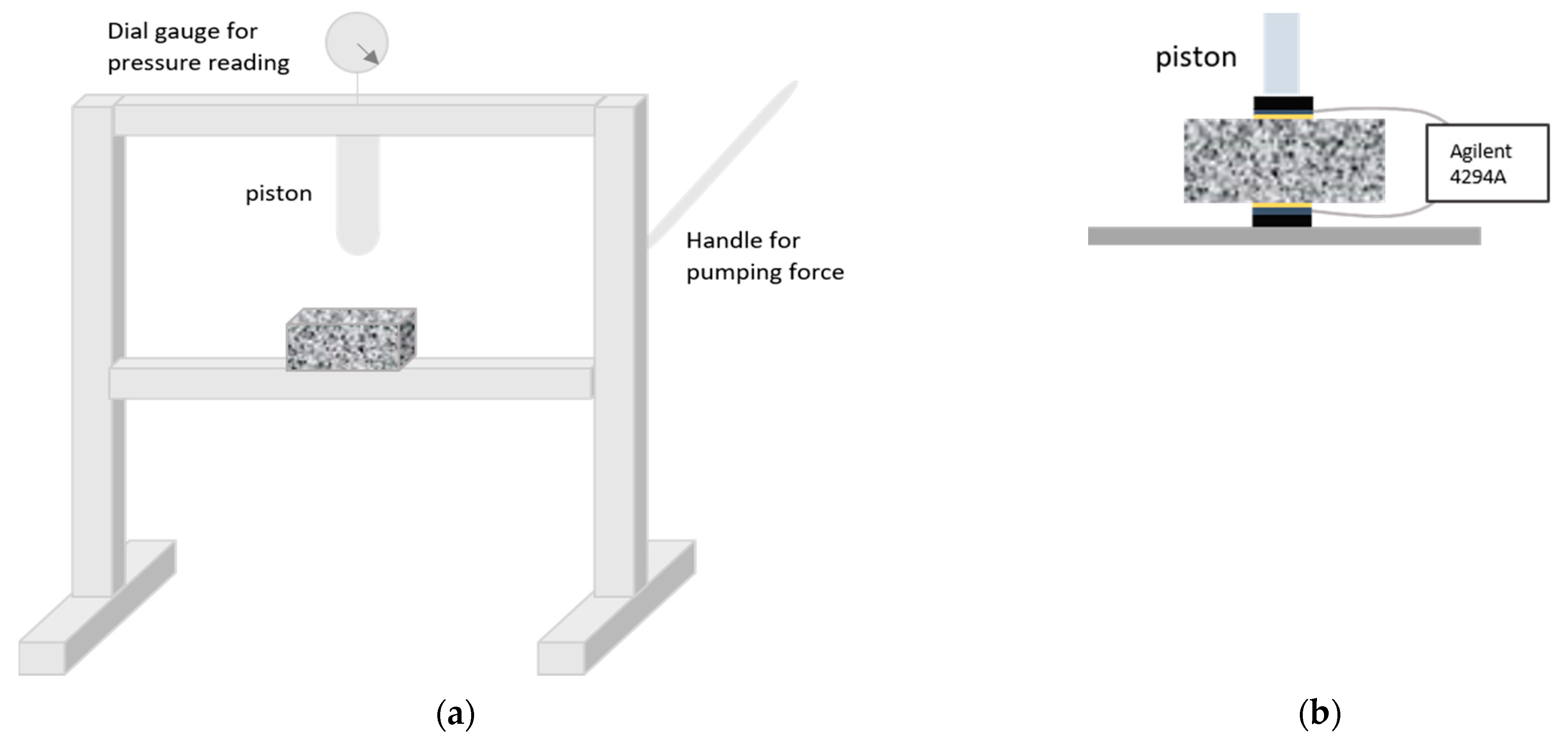
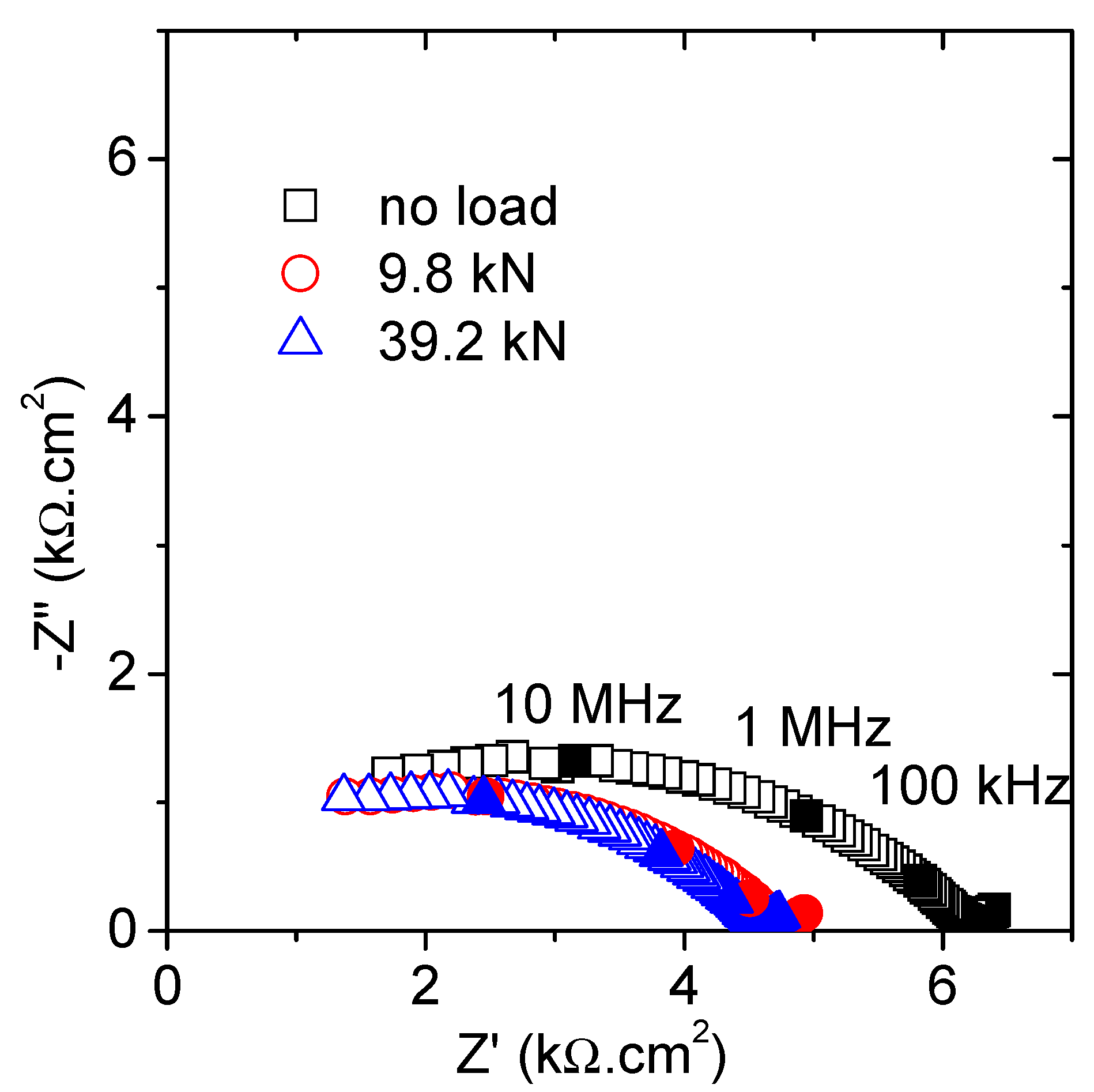
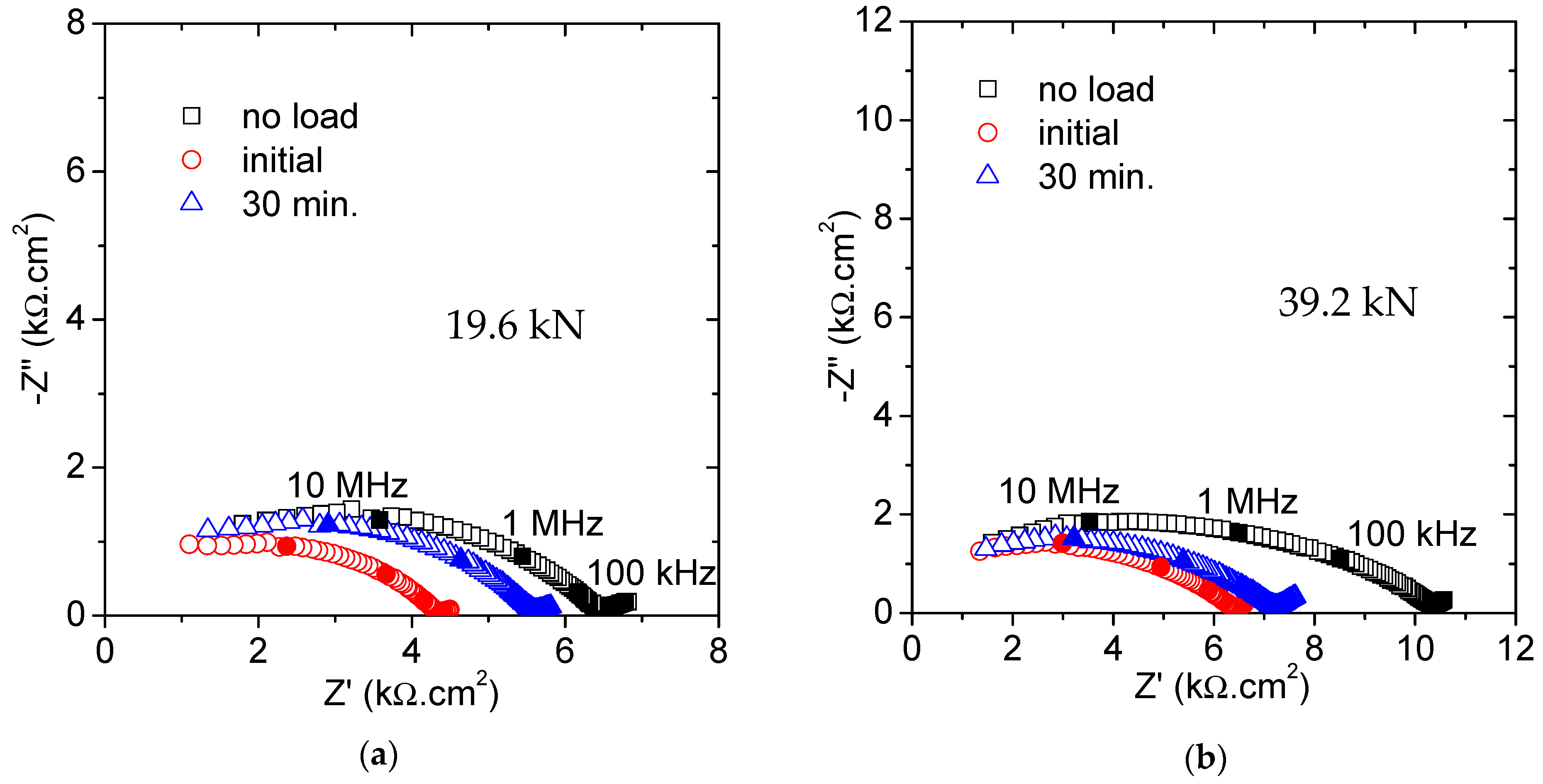
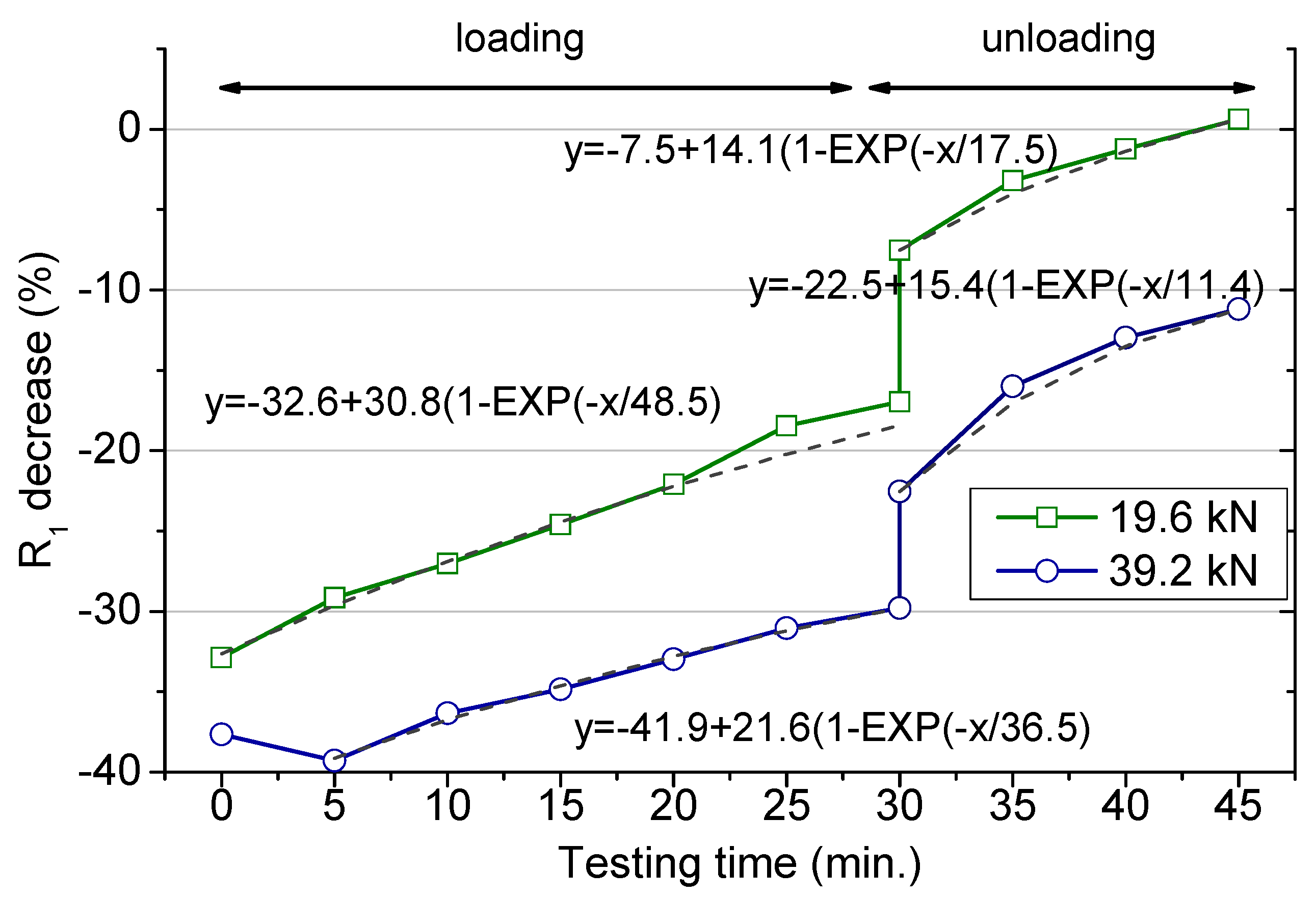

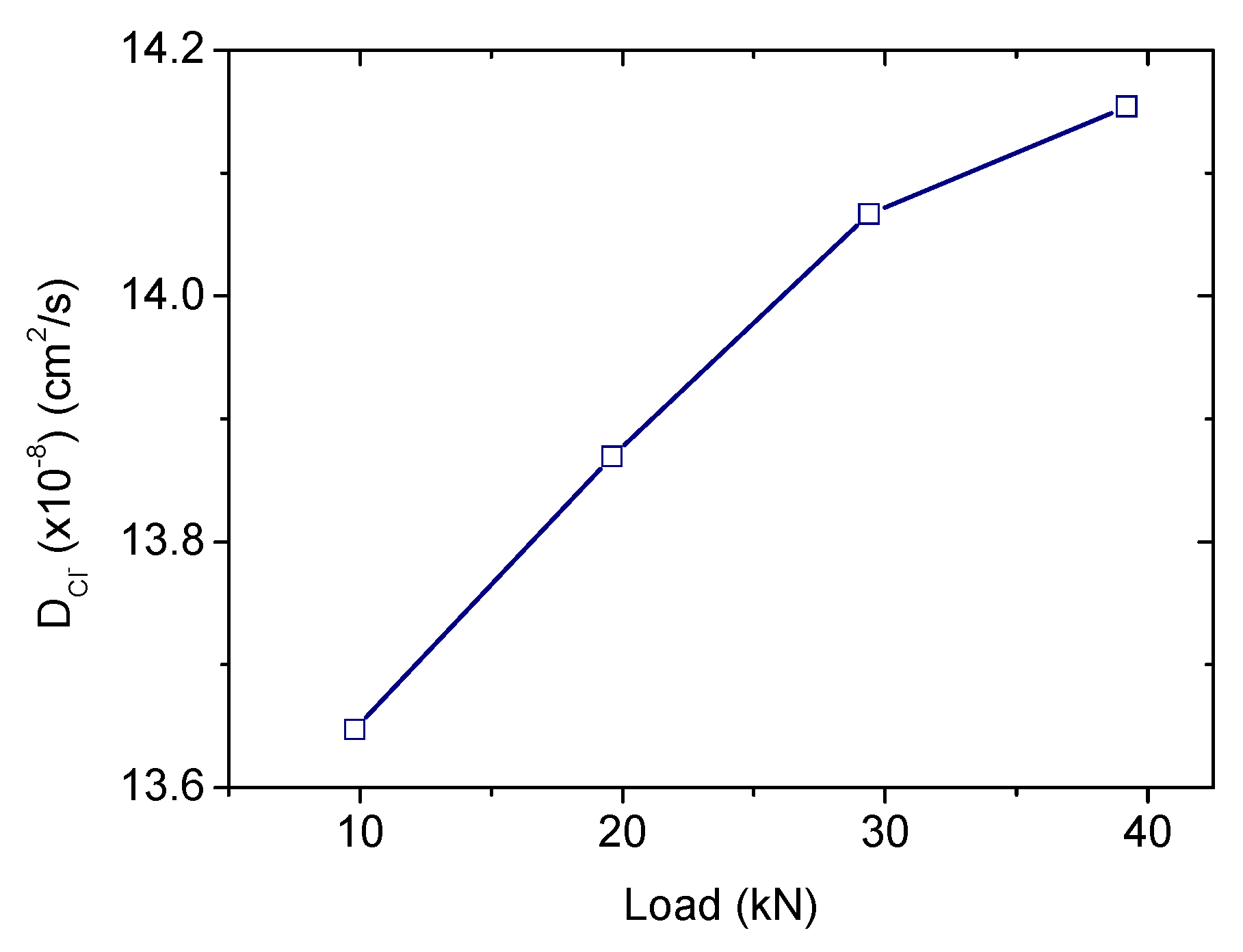
| Flexural Test | Compressive Test | Porosity | Average Pore Diameter |
|---|---|---|---|
| 2.9 ± 0.2 kN | 66.3 ± 4.9 kN | 10.1% ± 0.1% | 24.1 ± 5.9 nm |
| Experiment #1 | Experiment #2 | Experiment #3 | |
|---|---|---|---|
| Load (kN) | 9.8 19.6 29.4 39.2 | 9.8 39.2 | 39.2/unloading |
| Period | 10 sec | 30 min | 1 min/4 min |
| R1 (kΩ.cm2) | C1 (pF/cm2) | R2 (kΩ.cm2) | C2 (pF/cm2) | δ (nm) | |
|---|---|---|---|---|---|
| no load | 6.19 | 2.36 | 92.25 | 4.00 | 19.2 |
| 9.8 kN | 4.76 | 2.54 | 62.41 | 5.29 | 18.2 |
| 19.6 kN | 4.68 | 2.49 | 64.24 | 4.87 | 17.7 |
| 29.4 kN | 4.61 | 2.48 | 61.39 | 4.98 | 17.2 |
| 39.2 kN | 4.59 | 2.44 | 60.06 | 5.24 | 17.7 |
| R1 (kΩ.cm2) | C1 (pF/cm2) | δ (nm) | ||||
|---|---|---|---|---|---|---|
| 19.6 kN | 39.2 kN | 19.6 kN | 39.2 kN | 19.6 kN | 39.2 kN | |
| no load | 6.7 | 10.3 | 2.2 | 1.9 | 18.3 | 21.2 |
| initial | 4.3 | 6.4 | 2.6 | 2.1 | 23 | 14 |
| 30 min | 5.4 | 7.2 | 2.5 | 2.2 | 21.1 | 16 |
| 19.6 kN | 39.2 kN | |
|---|---|---|
| unloaded | 10.0 × 10−8 cm2/s | 6.3 × 10−8 cm2/s |
| 30 min | 12.1 × 10−8 cm2/s | 8.9 × 10−8 cm2/s |
| 1 day (fit) | 10.2 × 10−8 cm2/s | 7.9 × 10−8 cm2/s |
| load removal—1 day (fit) | 9.4 × 10−8 cm2/s | 6.8 × 10−8 cm2/s |
| Cyclic loading | ||
| unloaded | - | 10.1 × 10−8 cm2/s |
| 30 min | - | 13.0 × 10−8 cm2/s |
| 1 day (fit) | - | 10.6 × 10−8 cm2/s |
| load removal—1 day (fit) | - | 10.7 × 10−8 cm2/s |
© 2019 by the authors. Licensee MDPI, Basel, Switzerland. This article is an open access article distributed under the terms and conditions of the Creative Commons Attribution (CC BY) license (http://creativecommons.org/licenses/by/4.0/).
Share and Cite
Cabeza, M.; Díaz, B.; Nóvoa, X.R.; Pérez, C.; Pérez, M.C. The Effect of Loading on the Diffusivity of Chlorides in Mortar. Materials 2019, 12, 2527. https://doi.org/10.3390/ma12162527
Cabeza M, Díaz B, Nóvoa XR, Pérez C, Pérez MC. The Effect of Loading on the Diffusivity of Chlorides in Mortar. Materials. 2019; 12(16):2527. https://doi.org/10.3390/ma12162527
Chicago/Turabian StyleCabeza, Marta, Belén Díaz, X. Ramón Nóvoa, Carmen Pérez, and M. Consuelo Pérez. 2019. "The Effect of Loading on the Diffusivity of Chlorides in Mortar" Materials 12, no. 16: 2527. https://doi.org/10.3390/ma12162527
APA StyleCabeza, M., Díaz, B., Nóvoa, X. R., Pérez, C., & Pérez, M. C. (2019). The Effect of Loading on the Diffusivity of Chlorides in Mortar. Materials, 12(16), 2527. https://doi.org/10.3390/ma12162527






